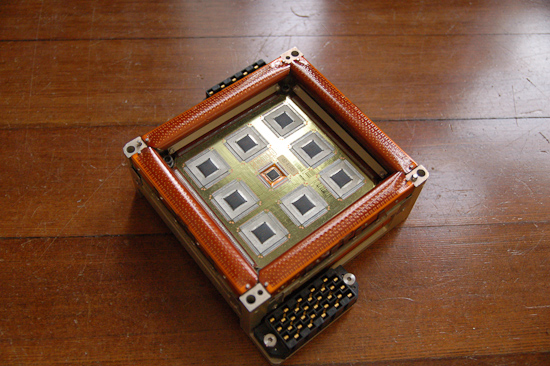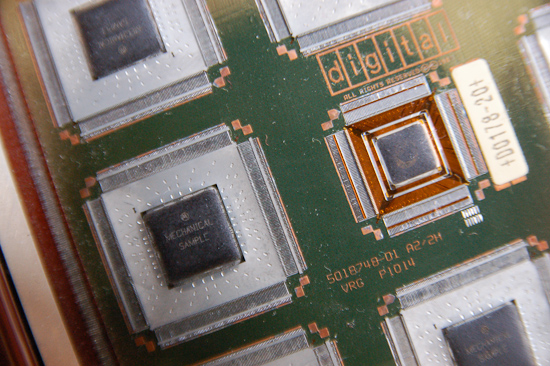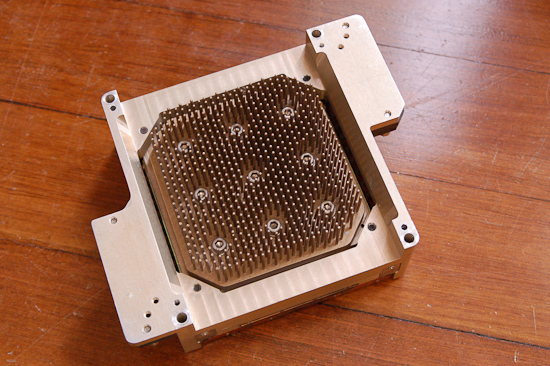Tuesday 19 October 2010 — This is 14 years old. Be careful.
Hewlett-Packard is closing its facility in Marlborough Massachusetts. It’s the old Digital Equipment MRO building, and many of the people here are Digital-vintage employees. In the process of cleaning out offices to prepare for the move, people find stuff they’ve had for a long time and no longer want. It goes into dumpsters or otherwise set out for others to consider. Most of it is true trash, empty pendaflex folders, boxes of floppies, manuals for products no one even remembers.
But occasionally there’s something truly interesting. Here’s one I found. I don’t know what it is, and am hoping someone has an idea.
It’s not large (5.5 inches square), but heavier than you’d expect:
The connectors on the side seem made for heavy-duty current, but are connected to fine traces in the ribbon material wrapped over the edges. The gold area between the chips is etched with perpendicular lines, but they don’t seem like circuitry, just a texture:
The “chips” seem permanently placed, and eight of them are stamped “Mechanical Sample”, with a Motorola logo:
Underneath looks like a heat sink, though it isn’t aluminum, with a hex nut for each of the nine chips on top:
Anyone know what this is? Can you explain its mysteries?




Comments
"This is from a GS160. What you see here is the Alpha CPU module. The GS160 supported many of the CPUs in 1 system. They also had Memory and IO modules that all looked the same. When VMS was running it would balance application across the CPU, Memory and IO modules. Worked great. It was the last Alpha systems that Digital or Compac produced before HP"
My guess is that this is an experimental mechanical mock-up for maybe PDP10 or ???
I was a DEC hardware designer for many years and I worked in product support for all Alpha systems my lst years at DEC/Compaq/HP.
From looking at pictures of CPUs of history, chips just did not look like that in the early '70s. Maybe the serial number is a red herring? I'm going with the VAX 9000 suggestion.
The circuits look like texture, because they are not actually doing anything, because the chips are not real. But the Motorola stamp and the heatsink implies that this is a 8xCore CPU. The VAX 9000 did indeed employ such things, and those chips were apparently made by Motorola, and it was presented in 1989, so the idea that this is a mockup for such a multichip unit seems to fit most of the evidence.
So, googling for '"Vax 9000" digital cpu' turn out images like this:
http://hampage.hu/vax/kepek/9000cpu-2.jpg
http://www.computerworld.com/computerworld/records/images/story/27Nvax_vax9000_secondary.jpg
Yeah, it's without a doubt a VAX 9000 CPU mockup.
It's a beautiful thing anyway, and I would love to have it decorate my office. I had a DEC core memory module once, but it got lost. They did many pretty parts, DEC. :-)
Mr Narhi, if you were a DEC design engineer in 70s/early 80s you would have thought that this was alien technology gifted to you. I worked LCG (KA10 to DECsystem20) and knew the ECL technology KL10 intimately and witnessed the demise of Jupiter. I remember when flex bus, ZIF chip socket technology was introduced.
These were custom chips developed for this system. I personally part of the team that troubleshot and did infrared heat tests on these units. We had special fixtures made for R&D that had vacuum mounts for our Oscilloscope probes with needle-like heads. We'd vacuum mount the scope prob near where we wanted to connect- then we had knobs that would adjust the x, y, and z axis of the probe to connect it on the chip pin in which we wanted to see the signal. This all had to be done under a microscope. I had a great time working on these and they brought me to CA to train some people, and I never left.
After that the UK swapped out the VAX9000 installations for two VAX6000s and I took the voluntary redundancy soon after. It was the beginning of the end for Digital- a great Company with superb ethics (sales-people worked in a non-commission environment and were paid salary increases based on customer satisfaction). Digital was number two in turnover in the computer market just behind IBM. It lost its way big-time when the all important CEO and founder couldn't find a successor that understood Engineering and the real market needs. The closest company to Digital in terms of ethical selling today is Cisco and happily they get both the Engineering and market needs spot on.
I am a collector and an educator, and I would like to display a VAX 9000 MCU at the tech fairs I exhibit at.
(my goal is to interest kids in educations and careers in technology -- see: makerfaire.com)
Please contact me.
If anyone knows how to contact Glenn: please let him know. Thanks.
BTW, as an interesting aside: I have now collected photos of 9 different VAX 9000 MCUs -- and each one has a different layout of chips from the others!
https://www.ebay.com/itm/302718180833
Ned: I would email you the 9 [now 10!] photos I have found on-line of different VAX 9000 MCUs, in case you'd like to post them here -- but I don't believe I have your email eddress. [or could I post them here myself, with some directions?]
Add a comment: